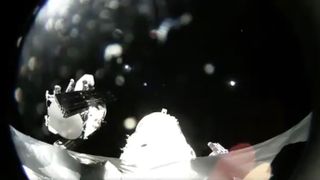SpaceX's Prototype Internet Satellites Are Up and Running

SpaceX's huge internet-satellite constellation is one big step closer to reality.
The company launched two experimental satellites today (Feb. 22) designed to help lay the foundation for Starlink, a network that, if all goes according to plan, will consist of thousands of spacecraft providing broadband internet service to people around the world.
"First two Starlink demo satellites, called Tintin A & B, deployed and communicating to Earth stations," SpaceX founder and CEO Elon Musk tweeted today. [In Photos: SpaceX's 1st Falcon Heavy Rocket Test Launch Success!]
"Tintin A & B will attempt to beam, 'hello world,' in about 22 hours when they pass near L.A.," he added in another tweet.
The experimental craft launched today as secondary payloads atop a Falcon 9 rocket from Vandenberg Air Force Base in California. The primary payload was the Paz Earth-imaging radar satellite, which will be operated by Spanish company Hisdesat. Paz was delivered to its desired orbit as well, Musk said.
SpaceX representatives have said they hope to have Starlink operating, in at least a limited capacity, by 2020. Tintin A and Tintin B will gather data necessary to help meet the Starlink goal, but a lot remains to be done, company representatives stressed.
"Even if these satellites work as planned, we still have considerable technical work ahead of us to design and deploy a low-Earth satellite constellation," Tom Praderio, a SpaceX firmware engineer, said during live launch commentary today
Get the Space.com Newsletter
Breaking space news, the latest updates on rocket launches, skywatching events and more!
"This system, if successful, would provide people in low to moderate population densities around the world with affordable high-speed internet access, including many who have never had internet access before," he added.
Musk revealed the broad outlines of Starlink in 2015, but SpaceX has been relatively quiet about the constellation since then. Last week, Federal Communications Commission (FCC) Chairman Ajit Pai announced that he had endorsed Starlink, but the plan has yet to garner official FCC approval.
The FCC has approved the requests of other companies that aim to establish big satellite-internet constellations, including OneWeb, Space Norway and Telesat.
Today's launch also featured SpaceX's first attempt to pluck a Falcon 9's falling nose cone out of the sky using a speedy, net-equipped boat named Mr. Steven. The attempt failed, barely: Mr. Steven was within a few hundred meters of the nose cone when it splashed down in the Pacific Ocean, Musk said today.
The $6 million nose cone, also known as a payload fairing, appeared to survive its journey to space and arrive back in good shape, Musk said. Photos from Mr. Steven show the fairing bobbing on the Pacific's waves, without any serious damage visible.
SpaceX wants to reuse fairings, just as it reuses Falcon 9 first stages, to lower the cost of spaceflight and help open the heavens to exploration.
Today's Falcon 9 launch featured a first stage that had flown once before, back in August 2017.
Follow Mike Wall on Twitter @michaeldwall and Google+. Follow us @Spacedotcom, Facebook or Google+. Originally published on Space.com.
Join our Space Forums to keep talking space on the latest missions, night sky and more! And if you have a news tip, correction or comment, let us know at: community@space.com.

Michael Wall is a Senior Space Writer with Space.com and joined the team in 2010. He primarily covers exoplanets, spaceflight and military space, but has been known to dabble in the space art beat. His book about the search for alien life, "Out There," was published on Nov. 13, 2018. Before becoming a science writer, Michael worked as a herpetologist and wildlife biologist. He has a Ph.D. in evolutionary biology from the University of Sydney, Australia, a bachelor's degree from the University of Arizona, and a graduate certificate in science writing from the University of California, Santa Cruz. To find out what his latest project is, you can follow Michael on Twitter.
